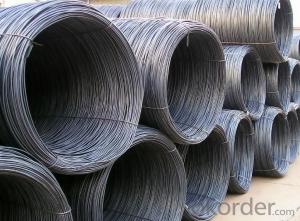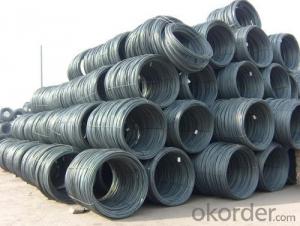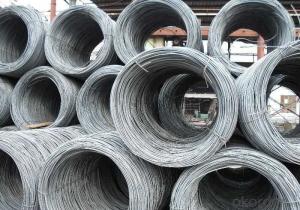High Quality Steel Wire Rod SAE1008 5.5mm
- Loading Port:
- Tianjin
- Payment Terms:
- TT or LC
- Min Order Qty:
- 50 m.t
- Supply Capability:
- 10000 m.t/month
OKorder Service Pledge
OKorder Financial Service
You Might Also Like
High Quality Steel Wire Rod SAE1008 5.5mm
Product Description:
Specifications of Wire Rod SAE1008:
Grade: SAE1008 Standard: ASTM
Diameter: 5.5mm
Alloy or Not: Alloy
Technique: Hot Rolled Place of Origin: China Mainland
Chemical Composition:
Please kindly find our chemistry of our material based on SAE1008 as below for your reference:
Grade | Chemical Composition (%) | |||||
C | Mn | S | P | Si | ||
SAE1008 | 0.10max | 0.32max | 0.045max | 0.040max | 0.30max | |
Mechanical properties | ||||||
Yield strength(N/mm2) | Tensile strength(N/mm2) | Elongation (%) | ||||
≥195 | 350-380 | ≥32 | ||||
Usage and Applications of High Quality Steel Wire Rod SAE1008 5.5mm:
After hot-rolled the products shaped into coil and delivery as finished product, including round, square,rectangular, hexagonal and so on. Since most of the products are round, it is generally called wire rod. Carbon steel wire rod is widely used in construction and manufacturing. Carbon steel wire rod is mainly used for reinforcement of reinforced concrete and welded structure or reprocessed (roberts , nail, etc.) materials, especially used to produce wire drawing, welding electrode, nails, spring, electronic, precise machinery parts and so on.
Packaging & Delivery of High Quality Steel Wire Rod SAE1008 5.5mm:
Packaging Detail: products are packed in coil and then shipped by container or bulk vessel
Each coil weight: About 2.05MT
Delivery Detail: within 45 days after received deposit or LC.
Label: to be specified by customer, generally, each bundle has 1-2 labels
Trade terms: FOB, CFR, CIF
FAQ:
Q1: Why buy Materials & Equipment from OKorder.com?
A1: All products offered byOKorder.com are carefully selected from China's most reliable manufacturing enterprises. Through its ISO certifications, OKorder.com adheres to the highest standards and a commitment to supply chain safety and customer satisfaction.
Q2: How do we guarantee the quality of our products?
A2: We have established an advanced quality management system which conducts strict quality tests at every step, from raw materials to the final product. At the same time, we provide extensive follow-up service assurances as required.
Q3: How soon can we receive the product after purchase?
A3: Within three days of placing an order, we will arrange production. The shipping date is dependent upon the quatity, how many sizes you want and the plan of production, but is typically 1 month to 2 month days from the beginning of production.
Images of High Quality Steel Wire Rod SAE1008 5.5mm:
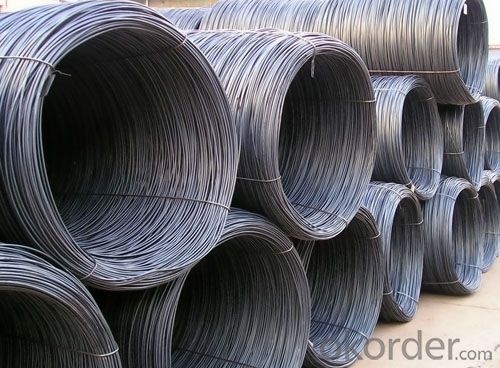
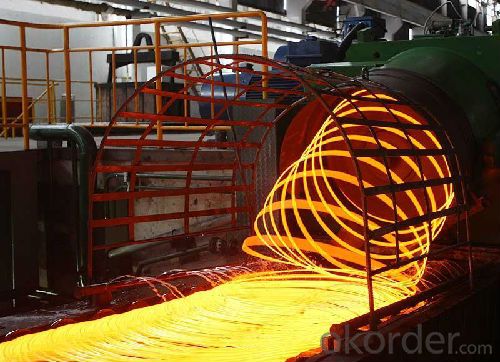
*If you would like to get our price, please inform us the size, standard/material and quantity. Thank you very much for your attention.
- Q:What are the different machinability testing methods for steel wire rod?
- There are several machinability testing methods available for steel wire rod. Some of the common methods used in industry include: 1. Turning Test: This method involves machining the steel wire rod using a lathe or turning machine. The cutting parameters such as cutting speed, feed rate, and depth of cut are varied to evaluate the machinability of the material. The tool wear, surface finish, and chip formation are observed and analyzed to assess the machinability characteristics. 2. Drilling Test: In this method, a drilling machine is used to create holes in the steel wire rod. The drilling parameters such as cutting speed, feed rate, and drill geometry are adjusted to determine the machinability. The hole quality, chip formation, and tool wear are examined to evaluate the performance of the material during drilling. 3. Tapping Test: Tapping is a common machining operation performed on steel wire rods to create threaded holes. In this test, the steel wire rod is tapped using a tapping tool. The torque required, tool life, and thread quality are assessed to determine the machinability of the material. 4. Grinding Test: Grinding is a precision machining process used to remove material from the steel wire rod. In this test, the steel wire rod is ground using a grinding wheel or abrasive belt. The grinding parameters such as grinding speed, feed rate, and grinding wheel specification are adjusted to evaluate the machinability. The surface roughness, material removal rate, and grinding wheel wear are analyzed to assess the performance of the material during grinding. 5. Hardness Test: Machinability can also be indirectly assessed by measuring the hardness of the steel wire rod. Hardness is an important mechanical property that affects the machinability of a material. Various hardness testing methods like Rockwell, Brinell, or Vickers hardness tests can be performed to determine the hardness of the steel wire rod. Higher hardness values indicate lower machinability, while lower hardness values suggest better machinability. These testing methods help manufacturers and engineers to select the most suitable machining parameters and tools for processing steel wire rods. By understanding the machinability characteristics, they can optimize the machining operations and improve productivity while minimizing tool wear and material waste.
- Q:What are the common applications of oil quenched and tempered steel wire rod?
- Oil quenched and tempered steel wire rod finds a wide range of applications across various industries due to its unique properties. Some of the common applications include: 1. Automotive Industry: Oil quenched and tempered steel wire rod is extensively used in the automotive industry for the manufacturing of various components such as suspension springs, engine valve springs, clutch springs, and transmission gears. The high strength and excellent fatigue resistance of this material make it ideal for these demanding applications. 2. Construction Industry: This type of steel wire rod is also widely used in the construction industry for the production of high-strength wire ropes, prestressed concrete wires, and reinforcement bars. The exceptional strength and durability of oil quenched and tempered steel wire rod make it suitable for withstanding heavy loads and extreme conditions in construction projects. 3. Manufacturing Industry: In the manufacturing sector, this steel wire rod is utilized for the production of fasteners, such as bolts, nuts, and screws, which require high strength and resistance to deformation. Additionally, it is used in the manufacturing of various machinery components, such as gears, shafts, and springs, where toughness and wear resistance are crucial. 4. Oil and Gas Industry: Oil quenched and tempered steel wire rod is extensively used in the oil and gas industry for applications such as wireline cables, well drilling components, and downhole equipment. The high tensile strength and corrosion resistance of this material make it suitable for withstanding the harsh conditions encountered in oil and gas exploration and production. 5. Aerospace Industry: This steel wire rod is also employed in the aerospace industry for the production of aircraft cables, landing gear components, and structural parts. The combination of high strength, fatigue resistance, and light weight makes it an ideal choice for these critical applications. Overall, oil quenched and tempered steel wire rod is a versatile material that finds applications in a wide range of industries due to its exceptional strength, durability, and resistance to deformation.
- Q:What are the main factors influencing the price of steel wire rod?
- The main factors influencing the price of steel wire rod include the cost of raw materials, such as iron ore and scrap metal, as well as energy costs, transportation and labor expenses, and market demand and supply dynamics. Additionally, government policies, trade tariffs, and currency exchange rates can also impact the price of steel wire rod.
- Q:How is steel wire rod used in the manufacturing of wire forms for fishing nets?
- Steel wire rod is a crucial component in the manufacturing of wire forms for fishing nets. The wire rod serves as the raw material from which the wire forms are created. Firstly, the steel wire rod is processed through a series of steps to transform it into a usable wire form. This includes cleaning, annealing, and drawing the wire rod to achieve the desired diameter and tensile strength. These processes ensure that the wire is strong and flexible enough to withstand the tension and stress it will experience when used in fishing nets. Once the wire rod is transformed into wire, it is then used to create the various wire forms required for fishing nets. These wire forms include various components such as hoops, rings, loops, and connectors that are essential for constructing a functional fishing net. The wire forms are created using specialized machinery and techniques, including bending, cutting, and welding the wire according to the specific design requirements. These wire forms are then assembled together to form the net structure. The use of steel wire rod in the manufacturing of wire forms for fishing nets provides numerous advantages. Steel is known for its high strength and durability, making it ideal for withstanding the harsh conditions and constant tension that fishing nets are subjected to. Additionally, steel wire rod is resistant to corrosion, ensuring that the wire forms will have a long lifespan even when exposed to water and other environmental factors. In conclusion, steel wire rod is a vital component in the manufacturing of wire forms for fishing nets. It serves as the raw material from which the wire forms are created, providing the necessary strength, flexibility, and durability required for a functional fishing net.
- Q:How is steel wire rod used in the manufacturing of wire for oil and gas pipelines?
- Steel wire rod is a crucial component in the manufacturing of wire for oil and gas pipelines. It is first processed into wire through various steps such as hot rolling, cold drawing, and coating. This wire is then further processed and turned into strands or cables that are used to reinforce the pipelines, providing strength and durability. The steel wire rod's high tensile strength and corrosion resistance make it an ideal material for withstanding the harsh conditions of oil and gas pipelines, ensuring their safe and efficient operation.
- Q:How is steel wire rod classified based on its surface condition?
- Steel wire rod can be classified based on its surface condition into three main categories: 1) bright or untreated surface, 2) coated or galvanized surface, and 3) coated and drawn surface. 1) Bright or untreated surface: This refers to steel wire rod that has not undergone any surface treatment or coating. It has a clean and smooth surface, free from any contaminants or oxidation. Bright steel wire rod is commonly used in applications where a clean appearance or high conductivity is required, such as in the manufacturing of electrical wires, cables, and springs. 2) Coated or galvanized surface: Steel wire rod with a coated surface has been treated with a protective layer, typically through galvanization or coating with zinc, to enhance its corrosion resistance. This coating acts as a barrier against moisture and other corrosive elements, making the wire rod suitable for outdoor applications or environments with high humidity or exposure to chemicals. Coated steel wire rod is commonly used in construction, fencing, and automotive industries. 3) Coated and drawn surface: This refers to steel wire rod that has undergone both a coating and a drawing process. The coating is applied to the wire rod before it is drawn through a series of dies to reduce its diameter and increase its tensile strength. This process results in a smooth and uniform surface, with improved mechanical properties. Coated and drawn steel wire rod is commonly used in high-strength wire applications, such as wire ropes, tire reinforcement, and suspension springs. In summary, the classification of steel wire rod based on its surface condition helps to determine its suitability for different applications, taking into account factors such as corrosion resistance, conductivity, appearance, and mechanical properties.
- Q:What are the common industry partnerships for steel wire rod?
- Common industry partnerships for steel wire rod include collaborations with steel manufacturers, wire drawing companies, construction firms, automotive manufacturers, and electrical equipment manufacturers. These partnerships help in the production, processing, and distribution of steel wire rod for various applications such as construction materials, wire products, automotive components, and electrical wiring.
- Q:What are the growth drivers for the steel wire rod industry?
- There are several key growth drivers for the steel wire rod industry. Firstly, the increasing demand for steel wire rods in the construction and infrastructure sectors is driving growth. As urbanization and industrialization continue to expand globally, the need for steel wire rods for various applications such as concrete reinforcement, fencing, and electrical transmission lines is on the rise. Additionally, the automotive industry is another significant growth driver. Steel wire rods are used in the manufacturing of automotive components such as springs, cables, and tire reinforcement, and as the automotive industry continues to grow, so does the demand for steel wire rods. Furthermore, the growth of the renewable energy sector, particularly wind power, is contributing to the expansion of the steel wire rod industry. Steel wire rods are used in the production of wind turbine towers and blades, and as the world increasingly focuses on clean energy alternatives, the demand for steel wire rods in this sector is expected to rise. Lastly, the continuous technological advancements in steel wire rod manufacturing processes are driving growth. Improvements in production efficiency, product quality, and cost-effectiveness are attracting more customers and expanding market opportunities for steel wire rod manufacturers. Overall, the growth drivers for the steel wire rod industry include the construction and infrastructure sectors, the automotive industry, the renewable energy sector, and technological advancements.
- Q:What are the safety precautions when working with steel wire rod?
- When working with steel wire rod, some important safety precautions to follow include wearing appropriate personal protective equipment (PPE) such as gloves, safety goggles, and steel-toed boots to protect against potential injuries. It is also crucial to ensure that the work area is well-ventilated to minimize exposure to any fumes or dust generated during the process. Additionally, workers should be trained on the correct handling and storage of steel wire rod to prevent accidents or mishaps. Regular maintenance and inspection of equipment used for handling the wire rod should be conducted to identify any potential hazards and ensure their proper functioning. Finally, workers should be aware of the correct techniques for cutting, bending, or welding the wire rod to prevent injuries and accidents.
- Q:How are steel wire rods used in the manufacturing of electrical conductors?
- Steel wire rods are an essential component in the manufacturing of electrical conductors. These rods are primarily used as the base material for producing high-quality wires that are then used in various electrical applications. To begin with, steel wire rods are first subjected to a series of processes to enhance their properties and make them suitable for electrical conduction. These processes typically include cleaning, heating, and rolling. Cleaning removes any impurities or contaminants present on the surface of the rods, while heating ensures that the steel is malleable and easier to shape. Rolling involves passing the rods through a series of rollers to achieve the desired diameter and shape. Once the steel wire rods are processed, they are then further transformed into wires through a process called drawing. During this process, the rods are pulled through a series of dies, which gradually reduce their diameter and increase their length. This results in the formation of a long, continuous wire with a uniform diameter. The wire produced from steel wire rods is highly conductive and exhibits excellent mechanical strength, making it suitable for various electrical applications. These wires are commonly used in the manufacturing of power cables, electrical cables, and wiring harnesses. They serve as the main conductor, allowing the flow of electric current from one point to another. Moreover, steel wire rods are also used to produce stranded conductors. In this process, multiple steel wires are twisted together to form a single conductor. Stranded conductors offer improved flexibility and mechanical durability, making them ideal for applications that require frequent movement or bending, such as electrical appliances or automotive wiring. In summary, steel wire rods play a crucial role in the manufacturing of electrical conductors. Their transformation into high-quality wires provides the foundation for the production of a wide range of electrical components used in various industries.
1. Manufacturer Overview |
|
|---|---|
| Location | |
| Year Established | |
| Annual Output Value | |
| Main Markets | |
| Company Certifications | |
2. Manufacturer Certificates |
|
|---|---|
| a) Certification Name | |
| Range | |
| Reference | |
| Validity Period | |
3. Manufacturer Capability |
|
|---|---|
| a)Trade Capacity | |
| Nearest Port | |
| Export Percentage | |
| No.of Employees in Trade Department | |
| Language Spoken: | |
| b)Factory Information | |
| Factory Size: | |
| No. of Production Lines | |
| Contract Manufacturing | |
| Product Price Range | |
Send your message to us
High Quality Steel Wire Rod SAE1008 5.5mm
- Loading Port:
- Tianjin
- Payment Terms:
- TT or LC
- Min Order Qty:
- 50 m.t
- Supply Capability:
- 10000 m.t/month
OKorder Service Pledge
OKorder Financial Service
Similar products
New products
Hot products
Related keywords
